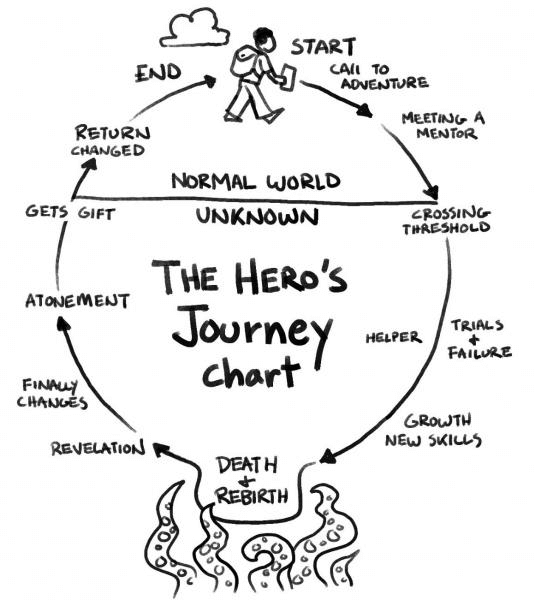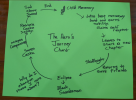Hello, first of all, I apologize for my bad English.
I've been studying some narrative structures and noticed some differences between the Western and Eastern methods of storytelling. Some people, especially in the West, swear that you can fit the "Hero's Journey" into every fantasy story, but I honestly fail to see that as true. I would like to know your opinions regarding that.

An example of the Hero's Journey structure
Berserk is an example where I can't see the Hero's Journey. Who is the Mentor? What is the Elixir? Where do you fit the "Death + Rebirth"? Some of these concepts vary depending on the Arc of the story. I can see Skull Knight as being the mentor a few times, along with Godo, but they don't even appear until later in the Golden Age Arc. I can see the Elixir being Caska's healing, but that will only be a goal until much later in the story. Some could say the Elixir is the healing of the Brand, but that is not even mentioned, much less a goal for Guts and his party. There is no atonement, and most of the time, it feels like Guts is wandering about, trying to find a meaning to his life, chasing revenge on the Apostles and the Godhand, and failing miserably, as much as we do with our struggles in life.
It is different from stories like Star Wars (Episodes IV, V, and VI) and Lord of the Rings, where you can see the outline of the story and identify the Hero's Journey.
Berserk, to me, sounds much more like a Greek Tragedy, very similar to Shakespeare's stories such as Hamlet, Macbeth, or King Lear, which, in my opinion, also don't follow the structures of the Hero's Journey.
I guess that what is off-putting to me is that these writing mentors and gurus swear they can fit the Hero's Journey into everything, but I don't think some stories fit into that structure. They also swear that if your story does not follow that structure, it will be bland, and boring and will fail to captivate the reader's attention.
Could you guys elucidate me?
Also, there is the Kishotenketsu structure that is way more prevalent in the East, where there isn't a main conflict or a villain to the story. It's seen in most Ghibli movies and other media.
All in all, sometimes I think that trying to use these narrative structures (The Hero's Journey, especially) may hinder the creativity and potential of your story instead of helping you.
Do you guys agree?
I've been studying some narrative structures and noticed some differences between the Western and Eastern methods of storytelling. Some people, especially in the West, swear that you can fit the "Hero's Journey" into every fantasy story, but I honestly fail to see that as true. I would like to know your opinions regarding that.

An example of the Hero's Journey structure
Berserk is an example where I can't see the Hero's Journey. Who is the Mentor? What is the Elixir? Where do you fit the "Death + Rebirth"? Some of these concepts vary depending on the Arc of the story. I can see Skull Knight as being the mentor a few times, along with Godo, but they don't even appear until later in the Golden Age Arc. I can see the Elixir being Caska's healing, but that will only be a goal until much later in the story. Some could say the Elixir is the healing of the Brand, but that is not even mentioned, much less a goal for Guts and his party. There is no atonement, and most of the time, it feels like Guts is wandering about, trying to find a meaning to his life, chasing revenge on the Apostles and the Godhand, and failing miserably, as much as we do with our struggles in life.
It is different from stories like Star Wars (Episodes IV, V, and VI) and Lord of the Rings, where you can see the outline of the story and identify the Hero's Journey.
Berserk, to me, sounds much more like a Greek Tragedy, very similar to Shakespeare's stories such as Hamlet, Macbeth, or King Lear, which, in my opinion, also don't follow the structures of the Hero's Journey.
I guess that what is off-putting to me is that these writing mentors and gurus swear they can fit the Hero's Journey into everything, but I don't think some stories fit into that structure. They also swear that if your story does not follow that structure, it will be bland, and boring and will fail to captivate the reader's attention.
Could you guys elucidate me?
Also, there is the Kishotenketsu structure that is way more prevalent in the East, where there isn't a main conflict or a villain to the story. It's seen in most Ghibli movies and other media.
All in all, sometimes I think that trying to use these narrative structures (The Hero's Journey, especially) may hinder the creativity and potential of your story instead of helping you.
Do you guys agree?
Last edited:


 I think it's safe to say it would have been character-driven and would have addressed and concluded all remaining major plot points in the series. I feel like that goes without saying!
I think it's safe to say it would have been character-driven and would have addressed and concluded all remaining major plot points in the series. I feel like that goes without saying!